Have you heard of ChatGPT? If you haven’t been completely off the grid, this revolutionary AI chatbot took the world by storm in November 2022. It rocketed to fame, becoming the fastest-growing consumer app ever, with over 100 million users in just two months (though dethroned by Threads in July 2023). For many, ChatGPT was their first foray into AI-powered search.
So, what does this mean for the future of search? This blog post dives deep into how AI is changing the search landscape. We’ll explore how brands can adapt their search strategies to thrive in these new AI-powered engines and even unlock the power of AI tools in their paid search campaigns.
Forget the days of endless scrolling and frustratingly vague answers. This revolutionary AI technology cuts through the noise, delivering a personalised and efficient journey to knowledge. It’s not just changing how we search, it’s transforming the entire concept.
Instead of a passive, transactional process, imagine an active, engaging discovery. AI personalises, contextualises and enriches your search experience, empowering you to become more informed and human-centric in your knowledge quest. So buckle up, because AI is driving the future of learning, making it smarter, faster and most importantly, yours.
For years, Google has been the undisputed king of search, but its own crown is starting to wobble. The integration of OpenAI’s ChatGPT into Microsoft’s Bing has sparked a new era, one where “answer engines” are reshaping the landscape.
Forget simply delivering lists of websites – these AI-powered tools aim to be your personal knowledge genie, providing direct answers to your queries. No more clicking through endless links.
Microsoft stepped forward as the first major player to unveil its AI-powered Search Engine Results Page (SERP), igniting the battle of the SERPs for technological dominance. Google, once unchallenged, now faces a formidable challenger.
This shift signals a fundamental change in how we search for information. It’s moving from a passive browsing experience to an active dialogue with technology. The future of search might not be about finding webpages, but having conversations with powerful AI assistants.
Microsoft’s move to acquire OpenAI, the brains behind the viral chatbot ChatGPT, throws a major wrench into Google’s long-held search engine supremacy. This isn’t just another acquisition, it’s a strategic play that could reshape the future of how we find information online.
In a 2023 press conference, Microsoft CEO Satya Nadella himself underscored the game-changing potential of AI, stating:
“AI will fundamentally change every software category, starting with the largest category of all – search”
Get ready to chat your way to info! As of March 2023, Bing unveiled its “AI-powered co-pilot for the web”. Ditch the endless scrolling – this new feature offers two ways to find answers:
Think of it as having a personal research assistant at your fingertips. No more jumping between links – just ask away and let the AI guide you through your information quest.
This marks a major shift in how we search. It’s not just about finding links anymore, it’s about having an effective dialogue with technology to get the answers you need, fast and efficiently.
Ready to give it a whirl? Head over to Bing and see how the AI co-pilot can streamline your search experience. You might just be surprised at how convenient and engaging it can be!
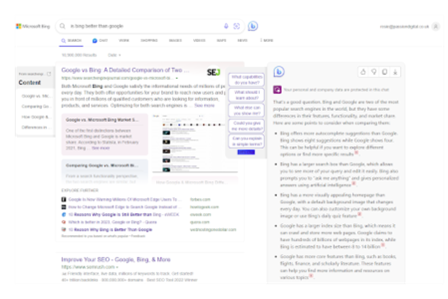 Google Gemini
Google GeminiFollowing Microsoft’s launch of its “AI co-pilot” for Bing, Google countered with its own offering: Gemini, a multilingual chatbot designed to answer your questions and engage in conversation. Launched just before Bing’s update, Gemini sparked initial excitement, but a rocky start with an incorrect response caused some consumer apprehension.
However, Gemini has come a long way since then. It’s now available in over 230 countries and 40 languages, accessible at https://gemini.google.com/.
But here’s the twist: Unlike Microsoft, Google hasn’t yet fully integrated Gemini into its main search engine (except for limited experiments in a few countries). This strategic difference highlights the distinct approaches taken by the two tech giants.
Microsoft focuses on immediate integration within Bing, offering users a blended experience of traditional search and AI-powered conversation. Google, on the other hand, seems to be taking a more cautious approach, keeping Gemini as a separate entity for further development and testing.
Only time will tell which approach wins the hearts (and searches) of users. Both Google and Microsoft are pushing the boundaries of AI and their innovations promise to revolutionise the way we interact with information online.
 Remember the time we asked an AI about the future of search and it got it totally wrong? Back in February 2023, we asked Jasper AI to explore Google’s AI strategy. Guess what? It gave us outdated info about a retired product, Google Duplex.
Remember the time we asked an AI about the future of search and it got it totally wrong? Back in February 2023, we asked Jasper AI to explore Google’s AI strategy. Guess what? It gave us outdated info about a retired product, Google Duplex.
This funny misstep highlights a key challenge for today’s AI tools: staying in the know. Just like you need fresh news and updates, AI needs constant learning to be truly helpful.
Now, let’s see how Bing Chat fares! When we asked about its own database freshness here’s what it said:
“The Bing Chat database is updated periodically based on the latest data and models available. According to the Microsoft CEO of Bing Search, Mikhail Parakhin, Bing Chat’s models take several months to train, so users can expect the models to be updated maybe three times a year or so. The models are updated outside of some small RLHF tuning runs. The last update for Bing Chat was on June 2, 2023, when the number of chat turns and the image creator feature were improved.”
Google Gemini (FKA Bard) said the following:
“The Bard database is continuously updated with new information from the web. This means that the information I have access to is generally up to date, but there may be some lag time for some topics. For example, if you ask me about a recent news event, I may not have the most up-to-date information if it happened within the last few hours.”
Remember the Google search page of ten years ago? A sea of blue links and all text. Compare it to today’s dynamic SERP! It’s a visual feast, brimming with videos, images and even predictive suggestions.
Here’s the mind-blowing part: we barely notice the gradual change. Google subtly evolves its SERP, subconsciously shaping our expectations for information. But step back and compare – the shift is undeniable!
So, what’s next? Buckle up, because the future of search is even more visual. Whether you’re searching by text, voice or image, expect results that are rich, engaging and visually captivating. Imagine immersive 3D experiences, interactive infographics and videos that answer your questions before you even ask them.
Here’s why this visual shift matters:
It’s an exciting time for search! Get ready to explore a world of information presented in ways you never thought possible. Embrace the visual wave and see how it empowers your search journey.
Hold onto your pixels, UK search marketers! 2024 welcomes Google’s Search Generative Experience (SGE), where an AI chatbot sits atop the SERP, dishing answers directly. Clicks to websites? Not necessarily.
Sounds scary, right? Don’t panic! While SGE might seem like a click-stealing monster, savvy marketers can adapt and thrive. Here’s the lowdown:
The SGE twist: Users type a query, an AI bot answers, websites become… optional? Yep, SGE aims to deliver info right there, potentially reducing clicks to your site.
Don’t despair! There’s room for everyone:
Remember: SGE isn’t here to replace websites, it’s here to enhance them. By providing the best possible answers, both within and beyond SGE, you’ll remain a trusted source of information in the evolving search landscape.
Want to dive deeper? Check out our blog post on how SGE will specifically impact paid search.
Stay ahead of the curve, adapt your strategies and embrace the exciting future of search!
Conquering SGE: How to make your content shine in Google’s AI playground
Google’s SGE throws a curveball at search strategies. But fear not! Adapt your content and emerge victorious in this AI-powered arena. Here’s how:
Embrace the multimedia feast:
Remember: While SGE might deliver direct answers, your content can still shine. By providing valuable, well formatted and diverse information, you’ll establish yourself as a trusted resource, even in the age of AI assistants.
 AI search is here: How to optimise paid search for Google’s SGE
AI search is here: How to optimise paid search for Google’s SGE
Get ready, paid search marketers! The rise of AI-powered search experiences like Google’s SGE demands a strategic shift. Here’s how to adapt and thrive in this new reality:
Embrace the intent spectrum:
Visuals rule the roost:
Paid search reigns supreme:
Master the AI toolkit:
Remember: SGE isn’t a replacement for good content or paid search fundamentals. It’s an opportunity to refine your targeting, embrace visuals and leverage AI-powered tools. By adapting your strategy, you can stay ahead of the curve and ensure your ads shine in the new era of search.
 Visual Search and the Rise of Lens Options
Visual Search and the Rise of Lens OptionsForget writing endless keywords. The future of search is visual and it’s happening right now! Instead of describing what you want, simply snap a picture and let your smartphone work its magic.
This isn’t just some futuristic fantasy. Visual search, like Google’s Reverse Image Search, has been around for over a decade. But thanks to AI and machine learning, it’s getting smarter and more powerful than ever.
Here’s how it works:
1. Snap it: Capture an image with your phone’s camera or upload an existing one
2. AI to the rescue: Advanced algorithms analyse the image, understanding its content and context
3. Results appear: See similar images, product listings, websites and even translations, all based on your snapped pic
Why is this a big deal?
So, what can you use visual search for?
Visual search is more than just a trend, it’s a fundamental shift in how we interact with information. So, grab your phone, start snapping and experience the future of search today!
 Google Lens
Google LensGoogle Lens launched in 2017 as an innovative standalone app and is now an essential part of the Google ecosystem. It’s readily available on your phone’s camera, Google Photos and even the web.
But what can you do with this magical lens? Buckle up, because the possibilities are endless:
Shop like a pro: See a stunning outfit or a must-have gadget? Snap it with Lens and find similar online options instantly. Say goodbye to endless browsing and hello to targeted shopping!
Ditch the QR code struggle: Forget downloading apps! Lens scans QR codes seamlessly, taking you directly to websites and information.
Unlock the world’s languages: Travelling abroad? Point your camera at menus, signs or even packaging and Lens translates them in real-time. Communication barriers? Not anymore!
Become a local expert: Ever wondered what that cool building is or where to find the best pizza? Lens analyses your surroundings, showing you reviews, hours and more, all at a glance.
It’s not just cool, it’s convenient: With Google Lens seamlessly integrated into various platforms, accessing its power is easier than ever. No need to jump between apps – simply point, click and explore!
The future of search is visual and Google Lens is leading the charge. So, open your camera, embrace the power of sight and see the world in a whole new way!
 Google Multisearch
Google MultisearchGoogle Multisearch launched in April 2022 and supercharges visual search by combining images with text prompts.
Here’s the magic:
1. Snap your object: Use Google Lens on the Google search app to capture an image, like a cool black and white jacket
2. Refine your vision: Add a text query like “blue and white” – presto! You’ll see similar jackets in that colour combination, instantly transforming your search results.
Multisearch breaks down barriers between image and text, allowing you to search with nuance and personalise your results like never before.
Ready to experience the future of search? Grab your phone, open the Google app and unleash the power of Multisearch. See the world differently, explore deeper and discover the perfect combination of image and text to answer every question.
 Multisearch understands:
Multisearch understands:
This powerful tool blends the best of both worlds: the immediacy of visual search with the precision of text queries. It’s like having a personal search assistant whispering answers directly into your eye (well, almost!).
Attention all search enthusiasts! On 17th January 2024, Google upped the ante on its already impressive AI-powered multisearch within Google Lens. This feature, now available everywhere in the US, lets you ditch the traditional search and step into the future of information discovery.
Here’s how it works:
1. Capture or upload your image: Snap a photo, upload an existing pic or even grab a screenshot
2. Ask your question: Don’t just look, interrogate your image! Ask anything related to what you see
3. Get AI-powered insights: Google’s generative AI goes beyond basic visual matches, delivering in-depth answers and insights tailored to your question
Gone are the days of endless scrolling and sifting through text walls. Multisearch empowers you to get straight to the answer you need, combining the power of visual search with the intelligence of AI.
Imagine these possibilities:
Multisearch is much more than a tool, it’s a conversation starter. Ask questions, explore deeper and unlock a world of information faster and easier than ever before. So, grab your phone, open Google Lens and experience the future of search today!
Say goodbye to app-hopping just to answer a quick question! Google’s new “Circle to Search” feature, launched on 31st January 2024, brings seamless information access right to your fingertips. Forget copying, pasting or navigating away from what you’re doing. With Circle to Search, finding answers is as simple as a circle.
Here’s the magic:
“With a simple gesture, users can find information,” says Elizabeth Reid, Vice President of Google Search, highlighting the feature’s intuitive nature. Whether you need to clarify a fact you see in a news article, understand a song lyric on YouTube or identify an actor in a movie, Circle to Search has you covered.
Currently available on select premium Android phones, this innovative feature promises to revolutionise the way we interact with information on our mobiles. So, ditch the app-hopping dance and embrace the convenience and efficiency of Circle to Search!
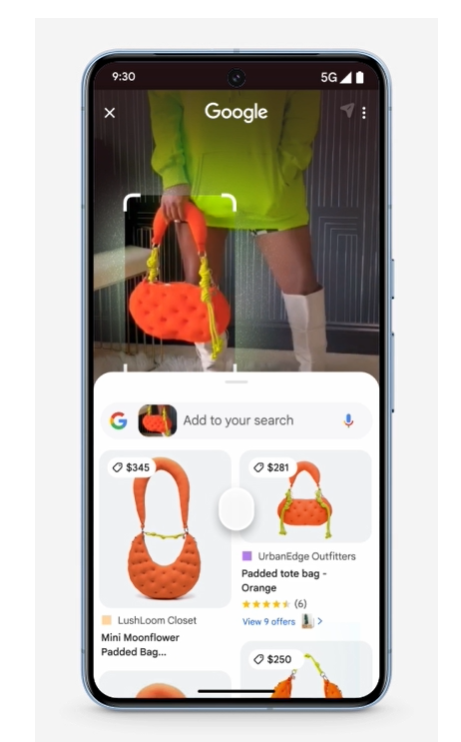 Source: https://blog.google/products/search/google-circle-to-search-android/
Source: https://blog.google/products/search/google-circle-to-search-android/
Generative AI is shaking up Google paid search! Buckle up, because new technology is streamlining the creation and optimisation of ad campaigns, making life easier for paid search professionals.
Instead of spending hours crafting ad copy and tweaking bids, imagine using AI to:
This isn’t just science fiction. Google is actively developing and integrating generative AI tools into its platform, with more on the horizon. This means paid search is becoming:
So, how can you prepare for this AI revolution? Stay informed about the latest developments, experiment with available tools and embrace a data-driven approach. The Future of Paid Search is generative and those who adapt will thrive.
Get ready to partner with AI in your paid search journey! Google Ads is rolling out chatbots that act as interactive AI assistants for PPC practitioners. Think of it as having a personal data scientist in your pocket.
These chatbots go beyond basic suggestions. They can:
What does this mean for you? Imagine freeing up precious time you used to spend on manual tasks. Instead, you can:
This isn’t just a chatbot, it’s a transformative collaboration. By teaming up with AI, you can:
Ready to embrace the future of PPC? Start your conversation with the AI chatbot in Google Ads and see how it can revolutionise your campaign management.
Get ready for an AI-powered ad creation revolution! Google is unleashing new technology that automatically generates and A/B tests thousands of ad variations, taking the grunt work of paid search for busy marketers.
Imagine this: instead of manually crafting countless ad headlines, descriptions and images, you feed your campaign goals and target audience to the AI. Bam! It spits out hundreds of unique ad combinations, each tailored to specific user segments and tested in real-time.
The benefits are game-changing:
This isn’t just about automation, it’s intelligent optimisation. Google’s AI analyses vast amounts of data to understand what resonates with your audience, creating ads that are:
This is a significant leap forward for paid search, promising:
Are you ready to embrace the Future of Paid Search? Dive into Google’s new AI-powered ad creation tools and watch your campaigns soar!
Remember the days of juggling separate campaigns for search, display and YouTube? Performance Max (PMax) changes the game by letting you reach potential customers across the entire Google ecosystem with a single campaign. Think maximum visibility, minimum hassle!
Here’s why PMax is a game-changer:
But creating all those visuals can be time-consuming, right? Worry not! Google Ads integrates cutting-edge AI technology to help you:
This isn’t just automation, it’s intelligent amplification. PMax and AI work together to:
So, are you ready to take your paid search campaigns to the next level? Embrace the power of PMax and AI and watch your reach, engagement and results soar!
Struggling to create high-quality product images for your search ads? Budget tight and can’t afford a fancy agency? Get ready for a game-changer! Google’s new AI-powered tool is here to revolutionise your PPC visuals, making stunning product images accessible and affordable for everyone.
Here’s how this magical tool can transform your campaigns:
But that’s not all! This tool is designed to be your creative partner, offering a whole range of features to elevate your visuals:
This isn’t just a tool, it’s a game-changer for small businesses and startups. Now, you can compete with the big players by creating professional-looking product images that resonate with your audience and drive conversions.
Ready to unleash the power of AI for your PPC success? Get your hands on this amazing tool and watch your search ads sparkle!
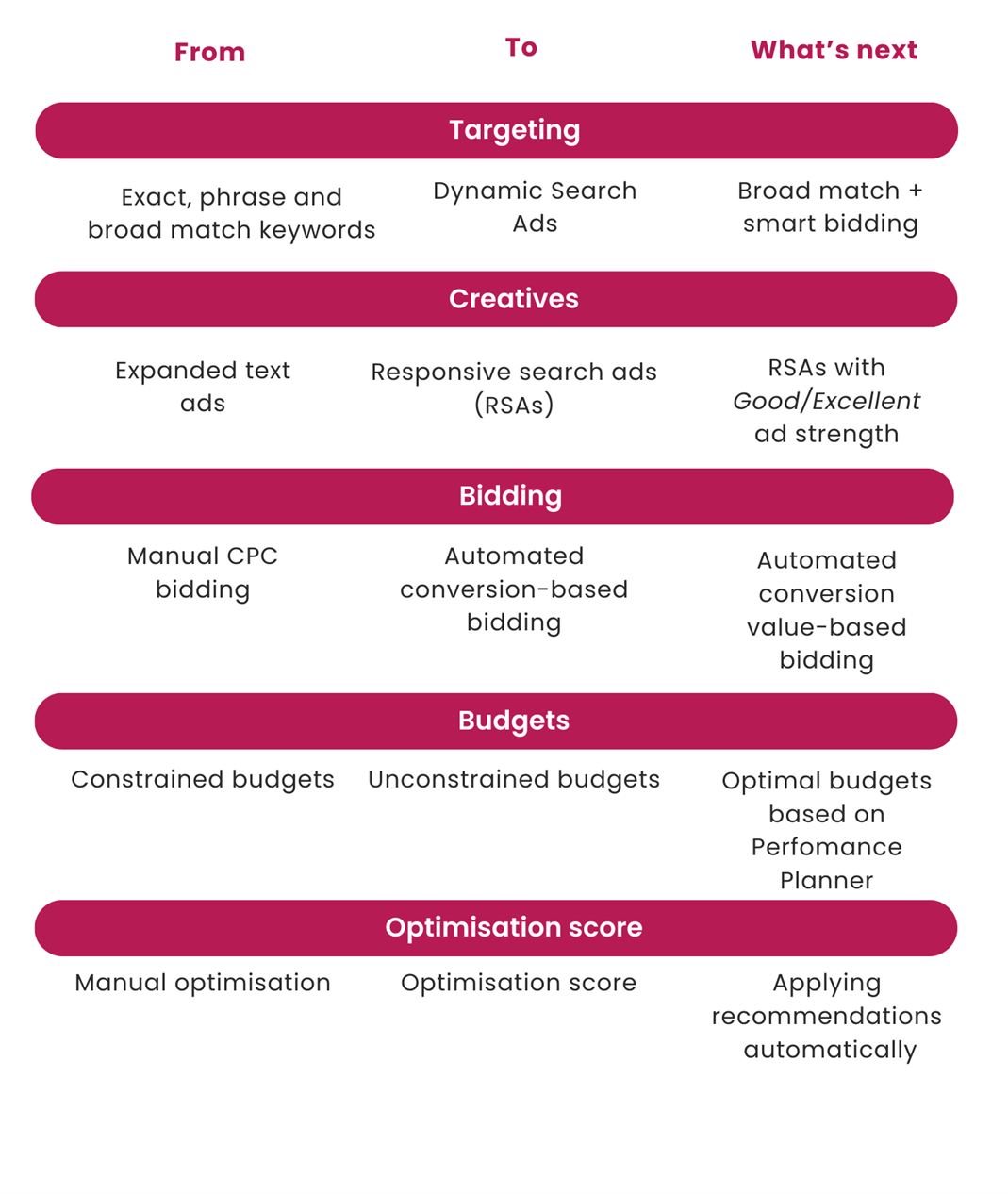 Where Does Passion See the Future of Paid Search Going?
Where Does Passion See the Future of Paid Search Going? “If you want to know the future, look at the past.”
Albert Einstein
We channeled our inner Einstein (okay, maybe not exactly Einstein) and looked back to 2009, the year our Joint Managing Director entered this dynamic field.
 “Paid search, it’s about optimisation, performance is delivered through keyword refinement, bid management and iterative testing. To make a difference you need to be trading the media every day, looking for the competitive advantage.”
“Paid search, it’s about optimisation, performance is delivered through keyword refinement, bid management and iterative testing. To make a difference you need to be trading the media every day, looking for the competitive advantage.”
Owen Osztotis, PPC Executive, 2009
“A paid search role is all about leveraging data and letting machine learning do the heavy lifting. There is still a place for manual optimisation, it’s calibrating the machine rather than operating it.”
Owen Osztotis, Head of Digital and Managing Director, 2024
The paid search landscape is evolving at warp speed. Gone are the days of manual bidding and keyword dominance. Automation reigns supreme, fueled by advanced tools like generative AI. But admist this technological surge, a crucial question begs to be answered: Do humans become obsolete?
Absolutely not! While these tools offer incredible power, they’re mere extensions of our strategies. The human touch remains paramount. Here’s why:
1. You’re the data whisperer: AI thrives on good data. It’s your responsibility to feed it the right information, ensuring optimal performance. Think of yourself as a data translator, bridging the gap between business goals and technical inputs
2. Calibration is key: Even the most sophisticated AI needs fine-tuning. You’re the calibration expert, adjusting settings and interpreting results to ensure the machine operates at its peak
3. Goodbye legacy, hello future: Letting go of outdated levers like manual bidding and keyword control doesn’t mean losing power. Instead, it frees you to focus on new frontiers, like website optimisation and quality score – crucial factors in the automated era
4. Metrics metamorphosis: The metrics that mattered yesterday might not hold the same weight today. Reassess your KPIs! Instead of fixating on unchangeable factors like CPCs, shift your focus to metrics you can impact, like conversion rates and return on ad spend
5. Debunking automation myths: Don’t fall prey to misconceptions. Automation isn’t a magic bullet. While it enhances efficiency and growth, it doesn’t eliminate the need for strategic thinking and human oversight
Remember, AI is a tool, not a replacement. Embrace its power, but never underestimate the vital role you play in guiding it. Together, humans and machines can conquer the ever-evolving world of paid search.
In the next part, let’s explore common automation myths and debunk them, empowering you to leverage this technology effectively.
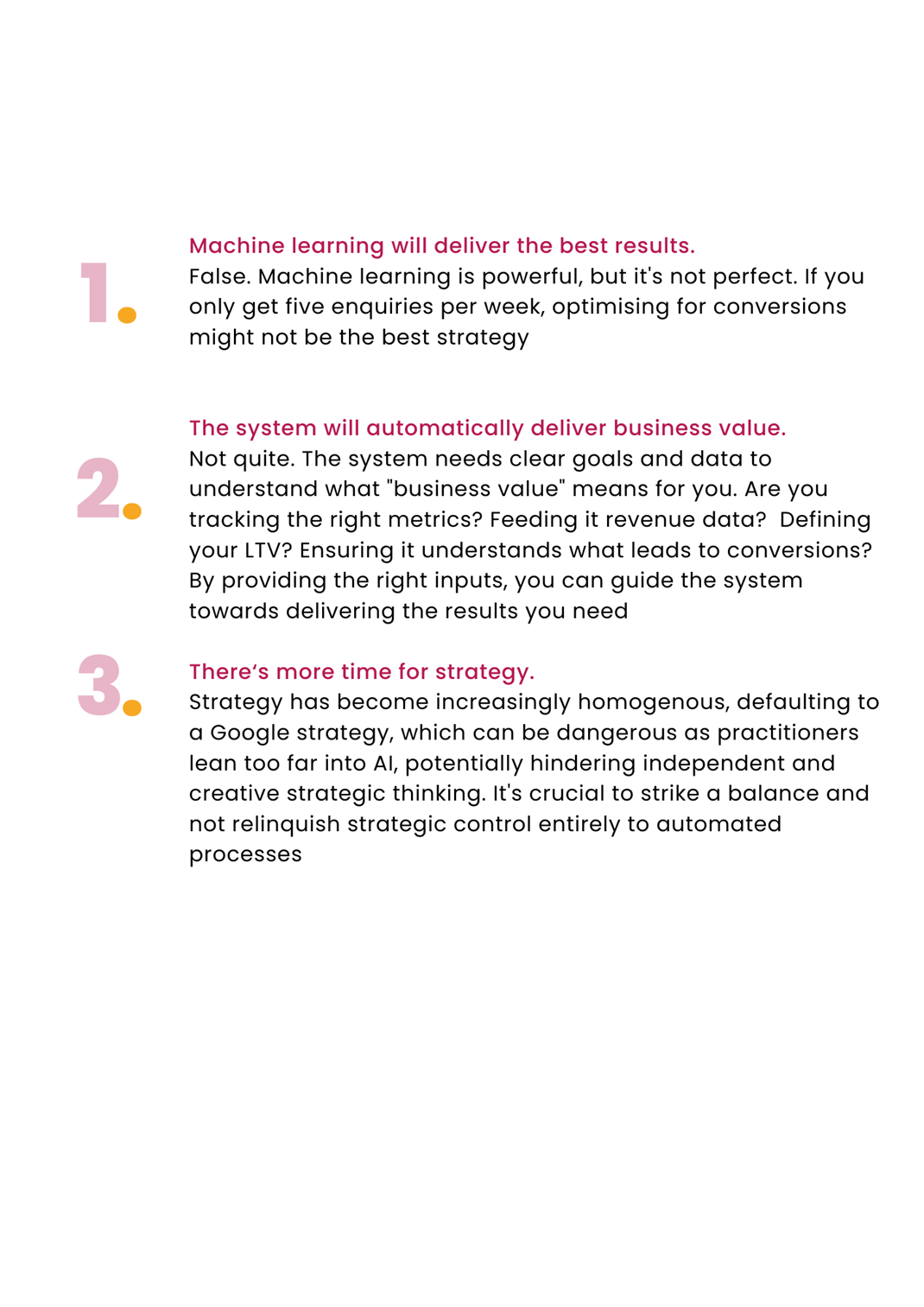
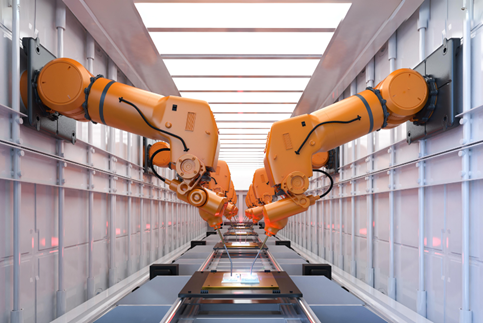 What Is the Future of Effective Paid Search?
What Is the Future of Effective Paid Search?The paid search landscape is on a whirlwind journey, propelled by automation, diverse ad formats and a deeper dive into customer journeys. But admist the technological frenzy, it’s crucial to remember that effective paid search will always be about human ingenuity.
Here’s the reality: the future isn’t a linear path, it’s a continous cycle of learning and optimisation. Imagine a loop where:
To thrive in this dynamic environment, future paid search practitioners need to be more than just technicians. They must be:
In essence, these qualities turn practitioners into master problem solvers. They can combine creative thinking with critical analysis to leverage technology, data and resources effectively. They don’t just manage campaigns, they solve problems.
So, forget about robots taking over. The Future of Paid Search belongs to those who can embrace technology as a tool, not a master. It belongs to those who can think strategically, learn relentlessly and adapt to the ever-changing landscape. Are you ready to become a top problem solver in the exciting world of paid search?
 AI has become the cornerstone of modern search, delivering personalised experiences and streamlined discovery. The ongoing duel between Google and Bing highlights the power of AI in shaping this dynamic landscape. Add in the rise of visual search and the future for marketers becomes even more intriguing.
AI has become the cornerstone of modern search, delivering personalised experiences and streamlined discovery. The ongoing duel between Google and Bing highlights the power of AI in shaping this dynamic landscape. Add in the rise of visual search and the future for marketers becomes even more intriguing.
But automation and data alone won’t win the race. While the Future of Paid Search is undoubtedly data-driven and automated, human expertise remains the key to calibrating AI systems and extracting maximum value.
That’s why at Passion, we believe in a synergy of creative thinking and critical analysis. We leverage AI’s power while maintaining a strategic human touch, allowing us to navigate the evolving search landscape and deliver exceptional results for our clients.
Ready to explore how AI can transform your search strategy? Get in touch with us today!